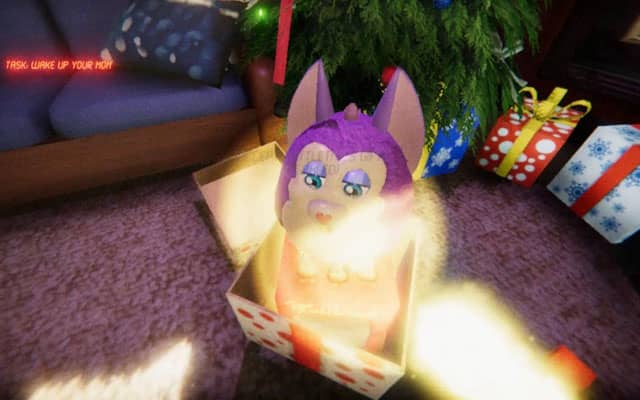You remember the Tattletail, right? It was a toy that was kind of popular in the late 90s that talked and learned things and looked kind of like a furry bird? Oh wait, that’s a Furby. Tattletail is a game that leans hard on 90s nostalgia for toys like the Furby and Teddy Ruxpin. It takes that nostalgia and mixes it in with the trendy “survive five nights equipped only with a faulty flashlight” gameplay. The unique premise was enough to get me to overlook the tired gameplay and give it a shot.
Tattletail is, in its own weird way, a Christmas story. It tells the story of an very young, unnamed child who sneaks out of bed at night to open their Christmas presents early. What does this kid find? A Talking Tattletail doll. The Tattletail is a Furby-esque doll that talks, eats, and lays eggs. This seems exciting at first, but it turns out that the Tattletail comes with one very severe drawback: the Mama Tatteltail. You see, Mama wants to gather up all of her babies who have snuck out of bed and she is deathly serious about it. In fact, the Mama had been recalled years earlier and seems to have killed employees at the factory where the Tattletails are made. After Mama shows up, it becomes a matter of keeping Mama away from your Tattletail until Christmas.
Tattletail was made with Unity, so it’s not exactly beautiful. However, the developers, Waygetter Electronics, clearly put in a lot of effort to make this game look a lot better than most other Unity games. There are very few of those ugly Unity stock assets that show up in a lot of cheap Steam games, and many of the custom models are very well done for such a small developer. The Tattletail doll itself is particularly good looking, which is especially impressive considering that it has multiple texturally different sufaces (both fur and plastic). The Mama also has moving parts, which is a rarity in a Unity game. It’s not great, but it’s fantastic for what it is.
The audio is one of the biggest stumbling blocks for “Tattletail.” It tries very hard to use sound as a major means of navigating the house, telling you how close you are to something, what side it’s on, etc. However, there is a big problem. You see, the house has a basement, and the sound does not really take which floor something is on into account when it uses your location to determine volume. So you can be standing on the wrong floor of the house while still hearing the sound at full volume as if you were in the same room as the source. The voice clips for the Talking Tattletail and the Mama Tattletail are all very well done and really do sound like something a 90s talking doll would make. However, they get incredibly repetitive incredibly quickly. The noises telling you that Mama is close are very creepy, though.
There is frankly very little about “Tattletail” that is unique as far as gameplay is concerned. This isn’t necessarily a bad thing. It’s a tried and true formula that happens to be very popular right now. The emphasis on sound rather than sight in this game is a little different, but it’s still pretty basic. If you play horror games, you’ve probably played at least a few games like this already.
I’m honestly very torn on “Tattletail.” What it does well, it does very well. However, most of the things that are really unique about “Tattletail” are the aspects that don’t really relate to the experience of it as a video game. There are a ton of interesting little secrets to be found out about “Tattletail” if you’re the sort of person who likes to dig into meta aspects of games like that. So if you’re just in it for the game, maybe save your five bucks. But if you want a weird little puzzle that stretches out past the game itself, “Tattletail” may be up your alley.









